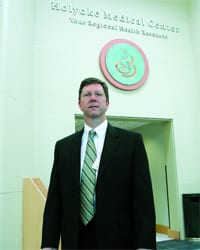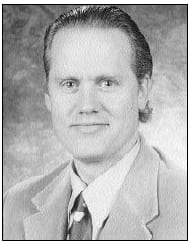Staying on the Cutting Edge Robotic Surgery and Other High-tech Advances Change the Face of Medicine
Dr. John Romanelli cringes a little when he imagines how some patients must perceive the hottest new trend in surgery.
“Robot is a bad term,” said Romanelli, director of — you guessed it — Robotic Surgery for Baystate Health.
“If I were a non-physician and I heard the term ‘robot,’ I would think of Rosie from The Jetsons or Isaac Asimov,” he explained. “If you look at the definition of robot, it’s an automatically guided machine able to do tasks on its own. That’s not what this device does. It’s not going to do operations while I’m off eating bon-bons in the surgical lounge.”
At the same time, however, Romanelli doesn’t want to undersell what the da Vinci Surgical System — which arrived in Western Mass. first at Baystate and is now used at several other hospitals in the region — actually does.
“It’s a remote device; I can sit in the corner of the room, operating the quote-unquote ‘robot,’ and what my hands do, the ends of the instrument do inside the patient,” he told the Healthcare News. “With laparoscopic surgery, which is already minimally invasive in nature, I’m able to do much more complex movements inside the abdomen without the need for a large incision.”
Because of that ability, da Vinci has revolutionized prostate surgery (its main application), gastric-bypass surgery, and hysterectomies, and holds great promise for oral surgery, thoracic surgery, and cancer-related operations, among other procedures.
By any measure, da Vinci is one of the most significant advances in medical technology of the last 10 years, a huge leap even over laparoscopic surgery, which was big news a decade earlier. But it’s not the only step forward; hospitals and other facilities have seen other high-tech changes as well, such as a flood of ever-improving imaging equipment that has given doctors exciting new tools for early diagnosis of disease, improving patient outcomes.
But none of this new technology is free — in fact, the price tag can be burdensome — which poses a huge challenge: which equipment represents the best investment in patient care? In an era of severe budget constraints, that’s a question not to be taken lightly, and one which will only become more significant as another decade of new technology dawns.
Surgical Precision
Time and again, the hospitals we spoke with tagged robotic surgery and advanced imaging equipment as the two stories of the decade when it comes to technology used to diagnose and treat patients.
“We’ve always been a leader in laparoscopic surgery, but this makes laparoscopic surgery easier and more accurate, and allows us to do more-complicated cases, minimally invasively, than we would have been able to do previously,” said Dr. Stephen St. Clair, division director of Urology for Berkshire Medical Center, which introduced the da Vinci system earlier this year.
He said robotic surgery is beneficial from two perspectives: those of the patient and the doctor.
“From the patient’s perspective, there’s less pain and quicker recovery, and from the physician’s standpoint, there are some things we can do better with the visualization and mobility that robotics gives us, even more than we could do with open surgery.”
Like many technological advances, robotic surgery starts with a good, established concept and takes it to another level. In this case, the model is laparoscopic surgery, which uses tiny incisions and cameras to accomplish what once required larger openings; the minimally invasive nature of laparoscopy means less trauma and better recovery times for patients.
The da Vinci system goes beyond that by adding a layer of machine precision aided by exceptional image quality, which is not only high-definition, but three-dimensional, Romanelli explained.
“With a left-eye camera and a right-eye camera, it’s true 3-D, and that does make a difference in the fidelity of what we’re doing,” he said. That, combined with the precision of the instruments following the surgeon’s remote lead, leads to better outcomes for patients, as well as significantly less back and neck pain for surgeons who don’t have to stand awkwardly over the patient. “In fact, 83{06cf2b9696b159f874511d23dbc893eb1ac83014175ed30550cfff22781411e5} of advanced laparoscopic surgeons end up with physical maladies related to their career. Sitting at the robot, I’m relaxed and comfortable. So there are advantages for the surgeon, not just the patient.”
But new technology tends to come with a hefty price tag, forcing significant budgetary decisions.
“Medical technology is obviously essential to advancing the care that’s delivered to our patients,” said Dr. Scott Wolf, vice president of Medical Affairs for Mercy Medical Center, adding that hospitals and other facilities — especially those running in or close to the red — are constantly weighing the costs of new equipment against the benefits to patients. It can be a tricky equation.
“Sometimes the latest technology comes at tremendous cost,” he said. “However, what’s not always intuitive is that technology can lead to expedited, definitive diagnosis of a particular disease state. That affords us the opportunity to intervene at a more opportune time, so the benefits of therapy can be maximized” — which, he added, increases the long-term effectiveness of medical treatment while reducing the cost.
“That’s why I don’t want the emphasis only on cost, although that has to be part of the equation” when considering new technology, Wolf continued. “I like to keep the patient at the forefront of those decisions.”
Take, for instance, Mercy’s 64-slice CT scanner, which provides extremely detailed 3-D images of heart chambers and arteries. As a cardiological diagnostic tool, this non-invasive, painless procedure can sometimes take the place of an angiogram, a test performed in a catheterization lab under local anesthesia. “The scanner is several times faster than other scanners and has unrivaled image quality,” Wolf explained. “It provides a detailed picture of organs with very sharp, clear, 3-D imaging.
“The impact has been absolutely dramatic,” he continued. “It really allows you to study the functioning heart and its major vessels in a beating heart, if you will. The scans can be timed so the images are gathered between the heart’s natural contractions, so visualization is not impaired by the motion of the heart. The specificity of images is dramatic.”
Laser Focus
Jim Keefe, vice president of Inpatient Services at Holyoke Medical Center, noted that CT scanners were considered almost a luxury a quarter-century ago; now, CT technology is constantly advancing. Indeed, some research hospitals are actually using 128-slice models.
The challenge, he said, is determining if and when to invest in a promising new technology. “We use a lot of different resources in the hospital to determine what the needs are of our patient population,” he explained. “There are some great pieces of technology that cost millions of dollars but benefit a small number of patients in the hospital’s outreach area.”
He cited the ‘Cyberknife,’ a cutting-edge device that treats brain cancers with radiosurgery, as a piece of equipment that few hospitals in a region need to have, as opposed to the broad use of CT scanners, which benefit a much wider swath of patients.
“A CT scanner is used for a large number of patient complains, to determine the right diagnosis,” he said. “We need to determine the cost-benefit ratio when making the decision to purchase new technology. You don’t necessarily buy one device that helps 10 people; you can only carve up a dollar in so many ways.”
As another example, also from the medical-imaging field, “for the longest time, hospitals didn’t have magnetic resonance imaging on campus,” Keefe noted. “Now, a larger number of patients benefit from MRI, which justifies having one on every hospital campus. We have MRI because a large number of patients benefit from that type of imaging.”
Another example of patient benefit catching up with technology is the use of lasers in the operating room. “So many procedures have benefited from the use of lasers,” he explained, “but if we had bought one 20 years ago, we might have used it once a month as opposed to multiple times each week.”
As robotic surgery moves beyond urology and a handful of other fields, expect it to expand into even more hospitals in the coming decade. In the meantime, few can predict what groundbreaking — and expensive — technologies will emerge in the decade to come.
“If the technology is out there and can improve patient safety, we should explore those opportunities,” Keefe said.
Added Wolf: “we’re committed to delivering the highest quality of care through whatever modalities give us that opportunity. If that care is through state-of-the-art technology, we are committed to doing so.”


